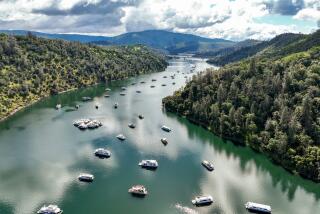River Enthusiasts Eager to Go With the Fast Flow
For several days in early June, Dave Hill, a river guide based in Rancho Cordova, picked up the phone to relay a message his customers didn’t want to hear: The waters were too high and strong for leisurely rafting trips on the American River.
Just a few miles away in Coloma, an hour’s drive east of Sacramento, the phone didn’t stop ringing. Don Hill, Dave’s brother and the owner of his own white-water rafting company, had to hire additional guides to accommodate “adrenaline junkies” in search of bumpy river rides.
“[Customers] know the river’s running faster, and that makes rafting great,” said Don Hill, who also organizes excursions on the American River. “People can’t wait to get on this flow.”
The Hills’ experiences illustrate the ups and downs of a dramatic runoff season created by extended rains, cooler temperatures and large quantities of snow deposited in the Sierra during what climatologists consider a very wet year for California.
The frigid, debris-packed runoff has doubled -- and in some cases sextupled -- water levels in many Northern and Central California rivers, and filled reservoirs to capacity.
“We’ve built up quite an enormous snowpack, and we’re looking at runoff projections in the southern Sierra of 20% to 50% above normal,” said Daniel Cayan, a climate researcher with the U.S. Geological Survey.
The rain and snow that often end in early March stretched through May, Cayan said, creating the highest river flows the Sierra range has seen in seven years.
The Sacramento River, according to the Bureau of Reclamation, a federal agency that manages water in the West, is flowing at 26,000 cubic feet per second -- two thirds higher than the year before. The San Joaquin River, at 7,600 cubic feet per second, is about six times “bigger” now than last year.
The volume of water running through river channels across the state is in large part regulated by a vast system of dams and reservoirs. Because many dams and reservoirs are filled to capacity, some of the water they hold must be released into rivers to avoid overflow.
“We’ve put 2 million acre-feet of water through the system this year, and we’re still in flood-control mode,” said Jeffrey McCraken, with the Bureau of Reclamation. “For comparison, a million acre-feet of water would be enough for a million families in Los Angeles for one year.”
Snowmelt runoff levels, which peaked in May, are expected to remain high through the summer, but flooding, McCraken said, is not a real concern.
“This isn’t 1997,” he said. “Then we had flooding in Northern California.”
Other authorities, however, are not so calm. Because runoff season will run strong through July, a month longer than usual, some worry that the tourist-heavy summer months will be filled with danger.
No central agency keeps statistics on the number of water accidents and casualties across the state, but several have been reported in recent weeks.
A 12-year-old girl and her father were swept away by strong currents in El Dorado County and drowned in Rock Creek, near the south fork of the American River, over Memorial Day weekend. And on June 14 four teenagers were pulled from the Kaweah River by Tulare County authorities after their raft was overturned, according to officials.
In some counties, authorities took precautions that ranged from temporarily closing parks dangerously close to the water, such as Skaggs Bridge Park in Fresno County, to handing out life jackets and keeping entire stretches of rivers off-limits to boats and swimmers.
“We’re telling people to go out there with a life jacket,” said Eric Coyne, a spokesman with Tulare County. “The water’s up, the water’s fast and it’s cold. People just need to be really careful right now.”
Water temperatures vary but tend to be several degrees colder in rivers that run “wild” or are unattached to reservoirs. One such river, the Tuolumne, was running last week at 42 degrees.
“Anything below 60 degrees can compromise people fairly quickly,” said Frank Gehrke, chief of snow surveys for the California Department of Water Resources.
But Gehrke said an abundant water supply has, all in all, been a boon for the state. And for Southern California, a region just beginning to rebound from a seven-year dry spell, the news was particularly welcomed.
“This season will help with groundwater recovery, with soil moisture; but it’s not a one-year thing,” he said. “With things like groundwater supply, it can take years, even decades, to recover.”
People’s needs, however, differ from nature’s. To keep them safe, portions of the Kings River stretching into Fresno and Tulare counties were closed by authorities for two weeks before reopening June 9.
Similarly, San Joaquin County authorities ordered sections of the Mokelumne River closed until early August following the death of a man who fell into the fast-moving current while boating with five friends over the Memorial Day weekend.
“We’re taking a zero-tolerance approach right now, and people will be cited,” said Deputy Les Garcia, a spokesman with the San Joaquin County Sheriff’s Department. “We want people to have fun, but we also want them to be safe.”
It is indisputable that the abundance of water has caused an upsurge in tourism. Nature enthusiasts have swarmed Yosemite National Park to gawk at extravagant waterfalls, trekked to pan for gold in Northern California streams and been drawn to river and lake fishing trips by a force nearly as strong as the currents themselves.
Nanci Sikes, executive director of the Tuolumne County Visitors Bureau, said June is seeing a 20% increase in the number of people showing up at visitor centers run by the organization, compared with the year before. The bureau represents close to 400 businesses sprinkled around the northern half of Yosemite National Park.
“Because the falls are fuller and more spectacular [than] they’ve been in years, more people are coming to the park,” she said. “Business is definitely up.”
And Silverwood Lake State Recreation Area, a park popular with boaters in San Bernardino County, began turning away people in May and continues to do so because of high visitor volume, said Roy Stearns, a spokesman with the California Department of Parks and Recreation.
“Big water years are years when visitorship goes up,” he said. “Water is a big draw for people who like to go out and recreate.”
Brent Shock, owner of Gold Prospecting Adventures in Jamestown, about three miles east of Sonora, said twice as many people have signed up for gold-panning trips and prospecting classes this year than the year before.
“Any time you get a resurgence like this, you’re re-shifting existing deposits and exposing new ones,” he said. “That translates into gold for us and for people who are looking for it.”
And for Don Hill, the white-water rafter in Coloma, a “good water year” has meant a roughly 25% increase in business.
“Some people were apprehensive” about the currents, he said. “Until we got them on the river.... We have not refunded anybody due to high water yet.”
More to Read
Sign up for Essential California
The most important California stories and recommendations in your inbox every morning.
You may occasionally receive promotional content from the Los Angeles Times.









